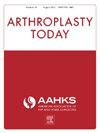通过保留臀骨的扩展后路翻修髋关节置换术可以获得与初次髋关节置换术相似的功能结果
IF 1.5
Q3 ORTHOPEDICS
引用次数: 0
摘要
背景:有报道称,与初次手术相比,二次全髋关节置换术(THA)的结果更差,部分原因可能是由于手术所需的暴露量增加。我们的目的是研究两组初级THA和改良THA的术后功能结果,当改良手术采用保臀延伸后路进行时。方法2016 - 2019年,从单一中心前瞻性招募两组51例原发性tha和21例改进型tha。两组术前、术后3个月和12个月分别采用定量步态分析和患者报告的结果进行评估。从步态分析中获得的运动捕捉数据计算髋关节和膝关节的运动学。运动学和患者报告的结果测量数据使用线性混合模型进行分析。统计参数分析补充了主要的运动学分析。结果与翻修组相比,初级组患者术前报告的预后指标更差。两组之间的步行速度没有差异。在3个月和12个月时,与初级组相比,改良组在步态站立后期的髋关节伸展度分别降低了9°和5°。这些差异在统计学上不显著,但效应大小的大小值得注意,表明存在功能缺陷(Cohen’s d分别= 0.64和0.54)。结论:在术后前12个月内,采用保留臀骨的扩展后路翻修THA可以获得与原发性THA相似的患者报告和步态结果。本文章由计算机程序翻译,如有差异,请以英文原文为准。
Revision Hip Arthroplasty Through a Gluteal-Sparing Extended Posterior Approach May be Able to Achieve Similar Functional Outcomes to Primary Hip Arthroplasty
Background
Revision total hip arthroplasty (THA) has been reported to have worse outcomes when compared to primary procedures, which may, in part, be due to the increased exposure required for the procedure. We aimed to investigate the postoperative functional outcomes of 2 groups of primary and revision THA, when revision procedures were performed using a gluteal-sparing extended posterior approach.
Methods
Two groups of 51 primary and 21 revision THAs were prospectively recruited from a single center between 2016 and 2019. Both groups were assessed preoperatively using quantitative gait analysis and patient-reported outcomes, and at 3 and 12 months postoperatively. Hip and knee kinematics were computed from motion capture data acquired at the gait analysis. Kinematic and patient-reported outcome measures data were analyzed using linear mixed models. Statistical parametric analysis complemented the main analysis of the kinematics.
Results
Patients in the primary group had worse preoperative patient-reported outcome measures when compared to the revision group. There were no between-group differences in walking speed. Hip extension in late stance phase of gait was 9° and 5° lower for the revision group when compared to the primary group at 3 and 12 months, respectively. These differences were not statistically significant, but the magnitude of the effect size was noteworthy suggesting a functional deficit (Cohen’s d = 0.64 and 0.54, respectively).
Conclusions
Revision THA using a gluteal-sparing extended posterior approach may be able to achieve similar patient-reported and gait outcomes with those of primary THA within the first 12 postoperative months.
求助全文
通过发布文献求助,成功后即可免费获取论文全文。
去求助
来源期刊

Arthroplasty Today
Medicine-Surgery
CiteScore
2.90
自引率
0.00%
发文量
258
审稿时长
40 weeks
期刊介绍:
Arthroplasty Today is a companion journal to the Journal of Arthroplasty. The journal Arthroplasty Today brings together the clinical and scientific foundations for joint replacement of the hip and knee in an open-access, online format. Arthroplasty Today solicits manuscripts of the highest quality from all areas of scientific endeavor that relate to joint replacement or the treatment of its complications, including those dealing with patient outcomes, economic and policy issues, prosthetic design, biomechanics, biomaterials, and biologic response to arthroplasty. The journal focuses on case reports. It is the purpose of Arthroplasty Today to present material to practicing orthopaedic surgeons that will keep them abreast of developments in the field, prove useful in the care of patients, and aid in understanding the scientific foundation of this subspecialty area of joint replacement. The international members of the Editorial Board provide a worldwide perspective for the journal''s area of interest. Their participation ensures that each issue of Arthroplasty Today provides the reader with timely, peer-reviewed articles of the highest quality.
 求助内容:
求助内容: 应助结果提醒方式:
应助结果提醒方式:


